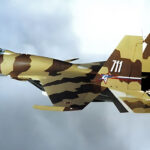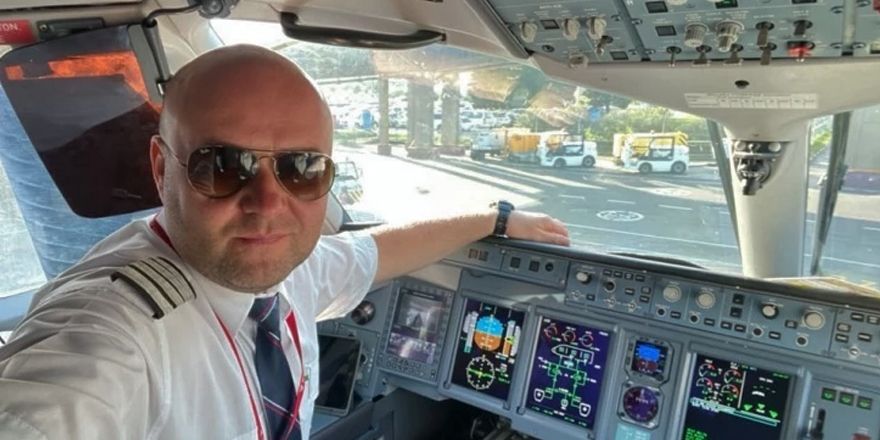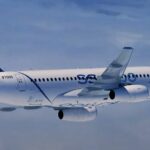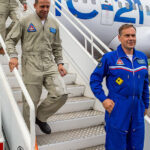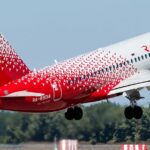The first prototype of the Sukhoi Superjet 100 was built in Komsomolsk-on-Amur on September 26, 2007. On 20 February 2008 the SaM146 engines were first flown in preparation for the maiden flight.
The first flight prototype (roll number 95001, tail number 97001) had a boom with sensors for measuring speed, altitude and angle of attack installed in the nose fairing. The sensors were located very close to the fuselage and measured the pressure in the air flow already disturbed by the fuselage, which distorted their readings. In the first test flights, in order for the sensors to measure the pressure in the undisturbed flow, they were installed in a long boom. Subsequently, the standard sensors were calibrated according to the boom readings, and the boom itself was dismantled.
On 14 May, the aircraft was tested on the runway for the first time. The aircraft taxiing and jogging were practised, jogging with a gradual increase in speed to 162 km/h, almost to the speed of the front landing gear strut breakaway.
On May 19, 2008 after the preparation of the SSJ100 aircraft on the ground test site of KNAAZ, the first flight model was towed to the launch pad where the pilots, Alexander Yablontsev and Leonid Chikunov, started the engines.
At 1647 hours, the aeroplane took off from the runway and, without retracting its gear, started to climb to an altitude of 1200 metres. Having gained the stipulated altitude, the pilots, at different speeds, assessed the characteristics of stability and controllability by roll in the range of ±20° and pitch in the range of 0-15°.
A simulated approach approach was conducted: descent from an altitude of 1200 to 900 m with a vertical speed of -5 m/s, at an altitude of 900 m the aircraft was brought to horizontal flight, and then back to an altitude of 1200 m. At an altitude of 1200 metres, the aircraft flew in a circle at a speed of 260-280 km/h. It then descended from 900 m to 150 m and passed over the runway at 260 km/h, with a subsequent climb to 900 m.
After four passes over the runway at different altitudes and a “box flight” (overflight along the defined perimeter), the first Sukhoi Superjet 100 prototype landed at 17h 54min. The first flight lasted 1 hour 05 minutes.
Leonid Chikunov, test pilot at Sukhoi Design Bureau: “The first flight is a very exciting, joyful and responsible event. We were preparing for it for three years, from 2005 to 2008. We went to the Design Bureau, held meetings with the engineering departments, discussed and made decisions in working groups on the cabin layout and operation of all the aircraft systems, we trained at the flight stands. This work was fruitful, and on the first flight the aeroplane reproduced the control model to which we were already accustomed by about 80%.
The Su-17 escort aircraft took off later than the first prototype Superjet and caught up with it already in the air.
“During the flight they were already accompanying us, guiding us, filming us on video. By the time we landed, the weather turned nasty, there was a thunderstorm. To land, the wind should not be more than 5 m/s, but our landing was just in the thunderstorm and there was a side wind of 15 m/s. Nevertheless, the aircraft performed well, it coped with this wind,” said Leonid Chikunov in an interview with the UAC press service.
According to Alexander Dolotovsky, Deputy Director for Development of the Regional Aircraft Branch of Irkut Corporation, the Russian regional aircraft project began with Mikhail Pogosyan’s idea to diversify production of the Sukhoi Holding Company. The goal was set to diversify the product line in 10 years so that up to 50% of the products would have civilian applications.
“In the early 2000s, the jet size was selected and the development of a family of 60 to 95 seats was started, they were called Russian Regional Jets – hence the abbreviation RRJ, which is the basis of our aircraft type certificate data cards,” says Alexander Dolotovsky. – The programme was launched in 2004. In the course of it, additional market research was carried out, which revealed that small jets would not be in demand in the market, so a modification with 95 seats remained in operation. Then the number of seats was increased to 100 and so our SSJ100 was born.
The SSJ100 took off less than four years after the program was launched. In another two years, the aircraft received a type certificate and began to perform commercial flights.

